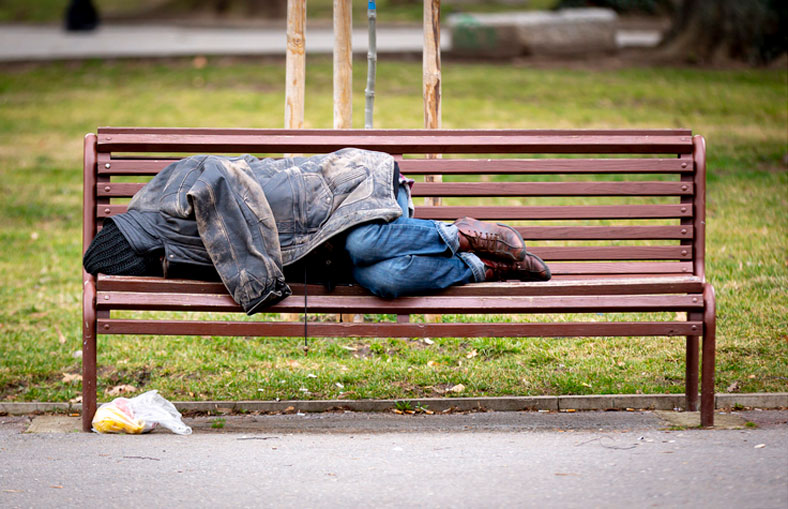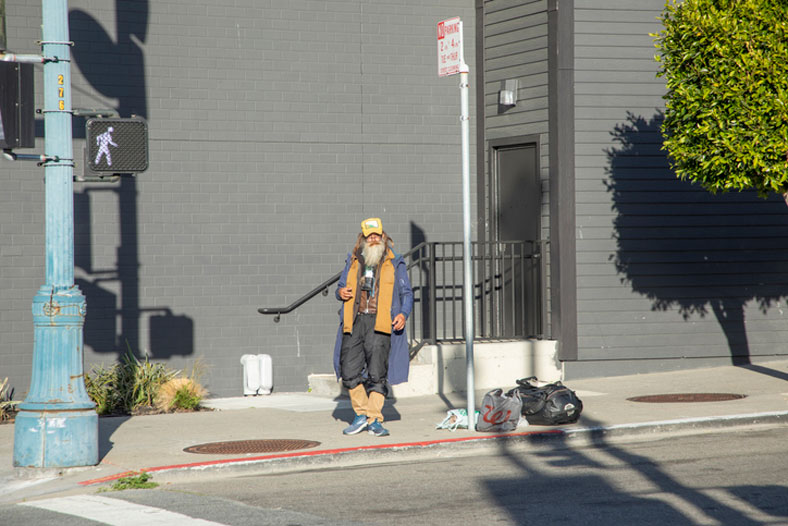Written by Sam Medley

According to the California Statewide Study of People Experiencing Homelessness out of UC San Francisco, data from October 2021 to November 2022 reveals that more than 171,000 Californians experience homelessness every day.
The study’s key findings illuminate some alarming statistics:
- The median age of participants was 47 suggesting that the homeless population is aging.
- Participants who report a Black (26%) or Native American or Indigenous identity (12%) were overrepresented compared to the overall population in the state.
- Discrimination, violence, incarceration, and other traumas were reported by respondents.
- The majority of respondents (82%) reported a past experience with a serious mental health condition
The authors of the study offered policy recommendations that rely heavily on the intervention of skilled social workers to address the homelessness problem with a focus on increased access to housing, expanded prevention efforts, behavioral health initiatives, employment support, outreach, and racial equity.
What’s in a Name? Housing Case Managers, Homeless Prevention Specialists, and Other Titles
Depending on their organization and role, social workers who work with the homeless and housing organizations in California may hold a variety of titles, including:
- Housing coordinator
- Housing services case manager
- Housing and resource navigator
- Housing advocate
- Housing outreach worker
- Housing counselor
- Housing placement specialist
- Shelter case manager
- Homeless prevention specialist
- Housing navigator
- Housing retention specialist
- Housing intake coordinator
Regardless of their title or the organization these social service professionals work for, the core responsibilities of their jobs support the psychosocial emotional needs of their clients and address economic and social structures that create barriers to access for homeless clients.
How Do Social Workers Help the Homeless and their Communities?
In a June 2023 statement to CalMatters regarding the UC San Francisco study, California Health and Human Services Secretary Mark Ghaly said, “As we drive toward addressing the health and housing needs of Californian’s experiencing homelessness, this study reinforces the importance of comprehensive and integrated supports. California is taking bold steps to address unmet needs for physical and behavioral health services, to create a range of housing options that are safe and stable, and to meet people where they are at.”
And the people who have the strongest impact are those in the trenches. Social workers spend their days interacting with clients and, in the case of homeless clients, helping them navigate the process of applying for housing and ensuring they stay housed. This involves interventions on multiple levels.

From providing counseling and emotional support to advocating for social justice, social workers help the homeless in many ways, such as:
- Connecting clients to temporary or transitional housing
- Providing rent assistance
- Making sure clients have access to food
- Referring clients to physical and mental health services
- Identifying training and employment programs
In addition to meeting with colleagues and visiting clients — whether in homes or public areas in the city — to help them obtain housing vouchers and stable housing, meeting with landlords, appearing in court, and advocating for their clients, social workers involved with unhoused people perform a variety of counseling, support, and community development activities.
These include:
Outreach and engagement. Social workers build trusting relationships with homeless people and connect them with shelters, food programs, health care facilities, and other essential services.
Assessment. Social workers conduct comprehensive assessments to identify the unique needs of each homeless individual, including physical and mental health care, substance use disorder treatment, and employment and housing assistance.
Case management. They provide ongoing support and case management to help homeless people and families access benefits, employment opportunities, and social services, ensuring they have the resources they need to exit homelessness.
Mental health and substance abuse treatment. Social workers can provide counseling services and refer homeless people to appropriate mental health and substance abuse treatment programs to address underlying issues that may contribute to homelessness.
Advocacy. Social workers advocate for homeless individuals to ensure they have access to their rights and entitlements, including social security, disability benefits, and health care.
Community integration. Social workers help homeless Californians reintegrate into the community by connecting them with education and vocational training programs and assisting with job placement.
Education and prevention. Raising awareness about homelessness and prevention initiatives is a key component of a social worker’s job.
Collaboration with other service providers. In addition to community awareness, social workers collaborate with various organizations and agencies, such as homeless shelters, youth organizations, and legal aid services, to coordinate care and tackle the problem of homelessness on a broader scale.
Advocating for policy change. Because homelessness is often a symptom of systemic social and political issues, social workers can have a big impact on homeless Californians by helping policymakers shape housing and public health laws and programs in the state.
Support for families. Many social workers say that the most rewarding aspect of their job is connecting with their clients and witnessing the progress of homeless families after they have found safe housing and can focus on the joys of being a family.
Crisis intervention. When social workers support people who have experienced a crisis, their actions and intervention can prevent these vulnerable individuals from becoming homeless.

Homelessness Risk Factors & Social Work Interventions for Californians
The UC San Francisco study, which followed 350 homeless people in California aged 50 and over, discovered several reasons for homelessness among California’s unhoused population, including interpersonal relationships and conflicts, domestic violence, illness, job loss, and substance misuse.
It’s not just economic factors that lead to homelessness. In fact, the study noted that “economic considerations interacted frequently with social and health crises” among leaseholders, and respondents who were previously in an institution cited a lack of transition services as the factor that led them to homelessness.
Thus begins a vicious cycle of homelessness and interpersonal and health problems, says Dr. Margot Kushel, director of the UCSF Benioff Homelessness and Housing Initiative.
“This lack of income and severe instability and housing precarity, it has spillover effects on people’s relationships, their use of alcohol and other kinds of problematic substances,” she told CalMatters.
Social workers have the skills and training — not to mention the compassion and empathy — to intervene in all the areas that pose the risk of homelessness. From age-related factors, to discrimination, incarceration, and even financial literacy, social workers can support people at high risk of homelessness and ultimately reduce the number of unhoused people in California.

California Organizations that Serve the Homeless
Social work practitioners help clients find temporary and permanent housing. The housing and shelter organizations that employ social workers include senior housing agencies, homeless shelters, and transitional living/halfway houses.
Nonprofit, government, and private homeless organizations in California include:
- Nonprofits:
- Hope of the Valley Rescue Mission
- Shelter Partnership Inc
- Solutions for Change
- Orange County Community Housing Corp
- Wounded Warrior Homes Inc
- La Casa De Las Madres
- Union Gospel Mission Sacramento
- Abode
- Large Organizations:
- People Assisting the Homeless (PATH)
- The People Concern (OPCC)
- LA Family Housing Corp
- Episcopal Community Services of San Francisco (ECS-SF)
- Rescue Mission Alliance
- Youth Shelter:
- Covenant House California
- Government Programs:
- California Department of Social Services
- Project Roomkey
- CalWORKs Housing Support Program (HSP)
- CalWORKs Homeless Assistance (HA) Program
- Bringing Families Home (BFH) Program
- Housing and Disability Advocacy Program (HDAP)
- Home Safe Program
- Community Care Expansion Program
- CalVet
- California Department of Social Services
These are just a few of the organizations that need qualified social work professionals to drive their mission of alleviating the homeless problem in California.

Prepare for Your Social Work Career
The first step toward becoming a part of California’s pioneering efforts toward ending homelessness is earning your Master of Social Work degree (MSW). Decide whether you will specialize in a particular area — such as gerontology, child welfare — or health care, and research the qualifications you need to work in California.
That decision will guide you in your selection of a MSW program and in seeking opportunities for experience. From there, you may decide to obtain your licensed clinical social work designation (LCSW), but licensure is not necessary for all social work positions in the state.
Note that having a state license and an MSW will open more opportunities for you at the beginning of your career and as you grow and develop professionally. According to the National Association of Social Workers, social workers with an MSW earn more than $13,000 more than those with BSW degrees.
California’s homeless need people like you to lift them up and give them a chance to rebuild their lives. Whether they were born into homelessness or struck by tragedy, they don’t have to stay there.
2022 US Bureau of Labor Statistics job market trends and salary figures for child, family, and school social workers, healthcare social workers, mental health and substance abuse social workers, and social workers (all other) are based on national data, not school-specific information. Conditions in your area may vary. Data accessed December 2023.
Discover more about other social work specializations in California.





